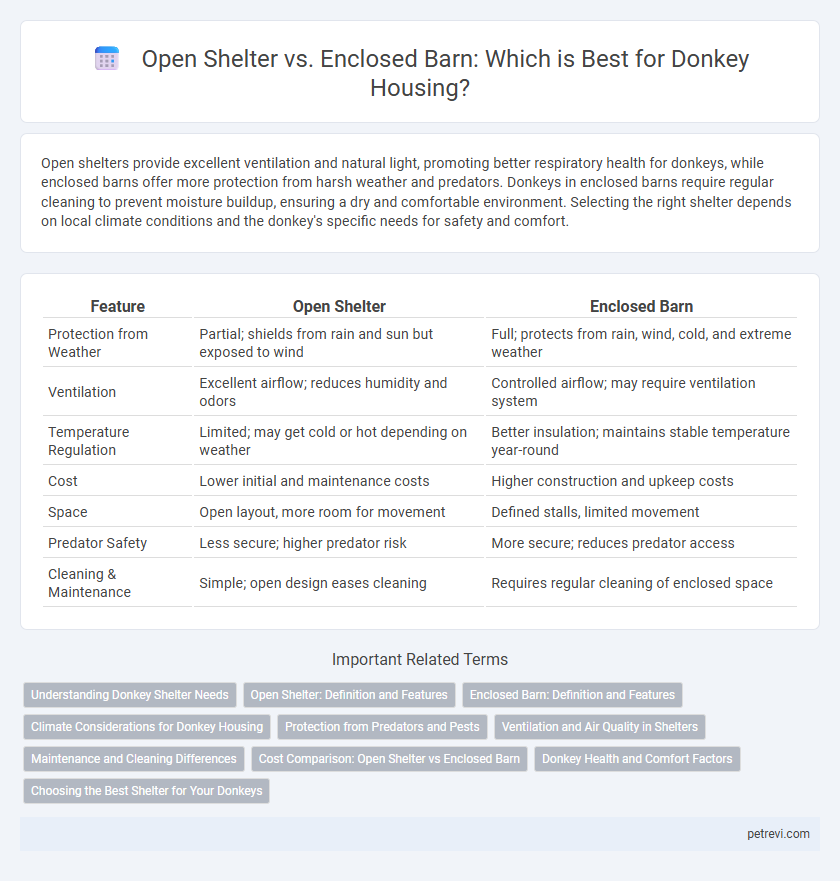Open shelters provide excellent ventilation and natural light, promoting better respiratory health for donkeys, while enclosed barns offer more protection from harsh weather and predators. Donkeys in enclosed barns require regular cleaning to prevent moisture buildup, ensuring a dry and comfortable environment. Selecting the right shelter depends on local climate conditions and the donkey's specific needs for safety and comfort.
Table of Comparison
| Feature | Open Shelter | Enclosed Barn |
|---|---|---|
| Protection from Weather | Partial; shields from rain and sun but exposed to wind | Full; protects from rain, wind, cold, and extreme weather |
| Ventilation | Excellent airflow; reduces humidity and odors | Controlled airflow; may require ventilation system |
| Temperature Regulation | Limited; may get cold or hot depending on weather | Better insulation; maintains stable temperature year-round |
| Cost | Lower initial and maintenance costs | Higher construction and upkeep costs |
| Space | Open layout, more room for movement | Defined stalls, limited movement |
| Predator Safety | Less secure; higher predator risk | More secure; reduces predator access |
| Cleaning & Maintenance | Simple; open design eases cleaning | Requires regular cleaning of enclosed space |
Understanding Donkey Shelter Needs
Donkeys require a shelter that protects them from extreme weather while allowing sufficient ventilation to prevent respiratory issues. An open shelter provides ample airflow and easy access, which suits donkeys' natural adaptability to varied climates, whereas enclosed barns offer enhanced protection from cold and wind but may risk poor air circulation. Optimal donkey shelter balances protection from rain and harsh winds with fresh air circulation to maintain their health and comfort.
Open Shelter: Definition and Features
An open shelter for donkeys is a three-sided structure designed to provide protection from wind, rain, and sun while allowing ample ventilation and natural light. Key features include a sturdy roof, partial walls, and an open front that promotes airflow, reducing heat buildup and moisture accumulation. This type of shelter encourages natural behavior and easy access, making it suitable for donkeys in mild to moderate climates.
Enclosed Barn: Definition and Features
An enclosed barn for donkey shelter is a fully covered structure designed to protect donkeys from extreme weather conditions such as rain, wind, and cold temperatures. Key features include solid walls, insulated roofing, proper ventilation systems, and secure doors to provide safety and comfort. This type of shelter helps maintain stable indoor temperatures, reduces stress, and supports overall donkey health and well-being.
Climate Considerations for Donkey Housing
Open shelters provide adequate ventilation and cooling, essential for donkeys in hot, arid climates where airflow reduces heat stress and prevents respiratory issues. Enclosed barns offer protection against cold, wind, and precipitation, crucial in colder or temperate regions to maintain body warmth and prevent illness. Selecting donkey housing based on regional climate enhances animal welfare and reduces health risks associated with temperature extremes.
Protection from Predators and Pests
Open shelters provide basic protection from predators but leave donkeys more exposed to pests like flies and ticks, increasing health risks. Enclosed barns offer enhanced security against predators such as coyotes and wolves by fully enclosing the space, reducing access points. Additionally, enclosed barns help minimize pest infestations through controlled environments, promoting better overall donkey welfare.
Ventilation and Air Quality in Shelters
Open shelters provide superior ventilation for donkeys by allowing continuous airflow, which helps reduce moisture buildup and prevents respiratory issues. Enclosed barns require installed ventilation systems to maintain air quality, as stagnant air can lead to ammonia accumulation from urine and increase the risk of respiratory infections. Proper ventilation is crucial in any donkey shelter to ensure a healthy environment and minimize stress-related health problems.
Maintenance and Cleaning Differences
Open shelters offer easier maintenance due to better ventilation, which reduces moisture buildup and minimizes odor, making cleaning less frequent and less intensive. Enclosed barns require regular cleaning to control higher humidity levels, which can increase the risk of mold and respiratory issues in donkeys, leading to more labor-intensive upkeep. Durable, easy-to-clean flooring materials and proper waste disposal methods are essential for both shelter types to ensure a hygienic environment.
Cost Comparison: Open Shelter vs Enclosed Barn
Open shelters for donkeys typically incur lower initial costs compared to enclosed barns due to reduced materials like framing, walls, and insulation. Maintenance expenses also tend to be lower for open shelters since they have fewer components susceptible to damage or wear. However, enclosed barns, while more costly upfront, provide better protection from extreme weather, potentially reducing veterinary costs related to environmental exposure.
Donkey Health and Comfort Factors
Open shelters for donkeys promote better ventilation and reduce the risk of respiratory issues by allowing fresh air circulation, which is essential for their respiratory health. Enclosed barns provide protection from extreme weather, preventing heat stress and sheltering donkeys from cold, wet conditions that can cause hoof problems and skin infections. Prioritizing shelter design that balances airflow with adequate protection enhances overall donkey comfort and supports their immune system function.
Choosing the Best Shelter for Your Donkeys
Open shelters offer superior ventilation and natural sunlight, reducing the risk of respiratory issues and promoting overall donkey health. Enclosed barns provide better protection from extreme weather and predators, crucial in regions with harsh climates or high predator presence. Selecting the best shelter depends on your local environment, balancing airflow with security to ensure optimal comfort and safety for your donkeys.
Open Shelter vs Enclosed Barn for Donkey Shelter Infographic

 petrevi.com
petrevi.com